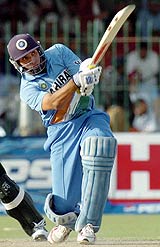
|

When conditions are demanding batsmen like Laxman have the skill to see out the tough periods
© AFP
|
|
The most unfortunate of events has led to one wrong being righted. India have lost their captain and best batsman to a finger injury, and Rahul Dravid is quite irreplaceable at the moment. But the tragedy has opened a door for VVS Laxman, who should have been on the flight to South Africa on November 12 in the first place.
There were several plausible reasons to keep Laxman out of the one-day team. One, he can bat only at number three; he is too reliant on subtlety and touch to be able to summon the violence required in the later overs. And for the top three slots, he has been competing with Sachin Tendulkar, Dravid and Virender Sehwag. Unlike the last World Cup, it was never a case of Laxman v Dinesh Mongia. Mongia was picked this time for a specific role: to bowl five overs of flat and stump-to-stump left-arm spin, the kind of which can be handy on slow and low West Indian pitches, and bat at No 7.
Two, he is a poor athlete. He can only field in the slips and is a liability in the outfield during the slog overs. Not the best fielding side, India can carry only so many men under the harsh lights of top-level international cricket. Also, he can't pinch a single or convert a two into three and always presents the threat of a run-out while at the crease.
Three, one-day cricket is a young man's game and, being on the wrong side of thirty, Laxman isn't part of the future. Tendulkar and Dravid select themselves and it makes sense to groom young players around them.
However, the circumstances have changed in the past few months, and changed circumstances warrant flexible thinking. On pitches that haven't been conducive to batting, some Indian batsmen have been exposed for their technical shortcomings and inability to adapt. Sehwag has continued to fail, Yuvraj Singh has lost form and Suresh Raina hasn't been good enough.
Most importantly, pitches in West Indies, Malaysia and in India during the Champions Trophy have changed, if only slightly, the pattern of one-day cricket. Seam, spin and indifferent bounce have tested batsmen and demanded application and technical adaptability. It has made for interesting cricket and raised the importance of primary batting skills. Unless the pitches change dramatically, the World Cup is likely to see 250-run totals rather than those in excess of 300.
A batsman like Laxman can be a misfit and a liability even on flat batting pitches where batsmen can plonk the front foot down and swing through the line. If you are looking at scoring over 300, you need batsmen who can clear the ropes every once in a while. One Dravid is enough to rotate the strike.
To chase 250, though, you need solid and sensible batting. And when conditions are demanding, you need batsmen who have the skill to see out the tough periods. Raina is a promising batsman and electric in the field. Mohammad Kaif is a fighter, a team-man and brilliant in the inner circle. But on batting pedigree, they don't equal to half of Laxman.
 Too often in the recent past, Laxman has batted like a man with his place on the line. Some of his doubts are perhaps self-inflicted. But to get the best out of him, he must be made to feel wanted and secure
Too often in the recent past, Laxman has batted like a man with his place on the line. Some of his doubts are perhaps self-inflicted. But to get the best out of him, he must be made to feel wanted and secure
 |
Conditions in South Africa were never going to be easy. To give themselves the best chance, India needed to pick their best players, not merely invest in hope. They got it half right by picking Anil Kumble - but chose Dinesh Karthik when Yuvraj's injury opened up a place.
Laxman now walks into a tough assignment in the middle of a series that cannot be won. There is no guarantee that he will play the next ODI and it will be too much to expect him to turn up and effect a turnaround. But having undone their first mistake, the selectors must now give him space and confidence to find his way back. He must feature in the World Cup plans now. With their batting in a crisis, India would only be fooling themselves if they think they still have the luxury of ignoring Laxman.
When going got tough for batsmen in the Champions Trophy, Australia found a saviour in Damien Martyn. He didn't need to hit the cover off the ball. He was deft and skillful. He created the angles and found the gaps. Laxman is a batsman in the same mould. But too often in the recent past, he has batted like a man with his place on the line. Some of his doubts are perhaps self-inflicted. But to get the best out of him, he must be made to feel wanted and secure.
When the Dravid-Chappell regime began, Indian cricket needed a shake-up. The team had become stale and lethargic. Some players needed to go, some needed to be woken up, and new players needed to be tried. In Munaf Patel, India have found a bowler for the future. And having served a necessary sentence, Zaheer Khan is back, fitter and hungrier. India must now pause, catch their breath, reassess their options, and choose the best available talent.
Sambit Bal is the editor of Cricinfo and Cricinfo Magazine

